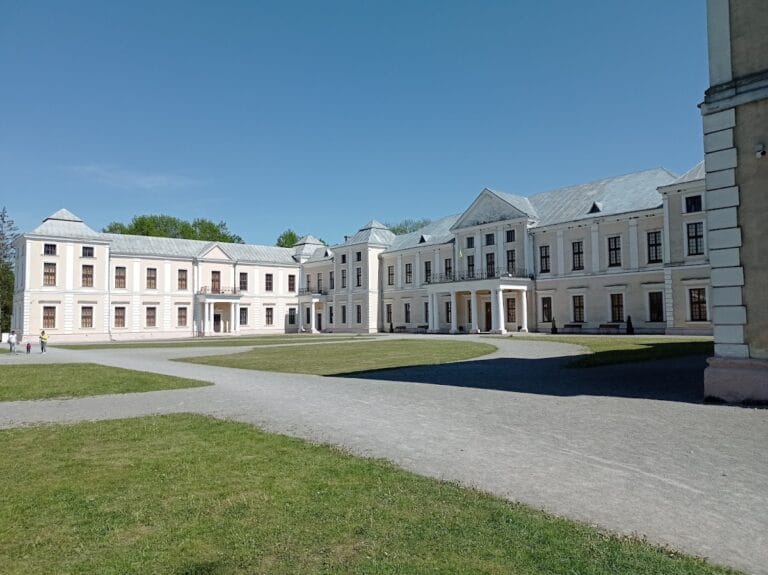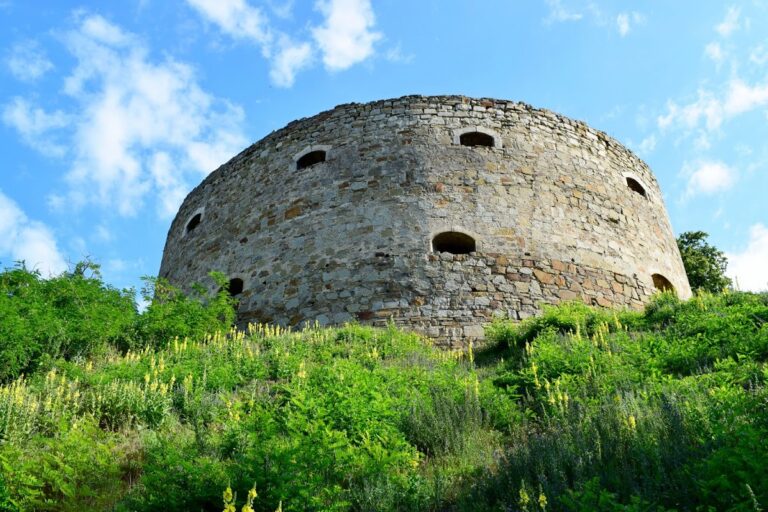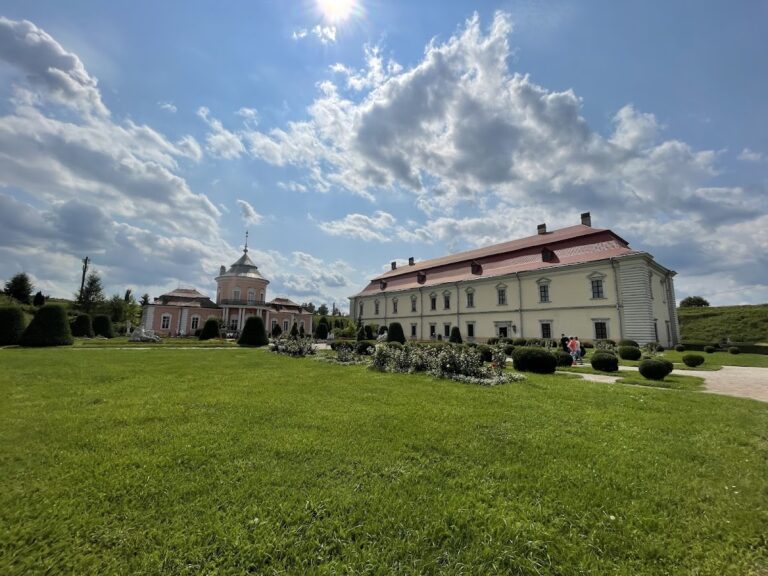Zbarazh Castle: A Historic Fortress and Museum in Ukraine
Visitor Information
Google Rating: 4.8
Popularity: Medium
Google Maps: View on Google Maps
Country: Ukraine
Civilization: Unclassified
Remains: Military
History
Zbarazh Castle is located in the town of Zbarazh, Ukraine. Its origins date back to the late 14th century when it was established as a fortress by the Ruthenian princes of the region.
The earliest known fortification on the site was founded in 1393 by Prince Dmytro Koribut. This wooden stronghold stood on what became known as the “Kniazha Hora” or Prince’s Hill, within the area that is now the village of Staryi Zbarazh, a suburb of modern Zbarazh. This initial fortress suffered destruction twice during raids by Crimean Tatars, once in 1474 and again in 1598, which underscored the region’s vulnerability to steppe incursions.
In the early 17th century, a new phase of construction replaced the earlier wooden structure. Between 1626 and 1631, under the patronage of the Polish noble Krzysztof Zbaraski, the present stone castle was built. Its design was crafted by Italian architect Vincenzo Scamozzi, known for his treatise on universal architecture, and construction was overseen by Venetian military engineer Andrea del Aqua, with probable input from Dutch engineer Henryk van Peene. This period marked the castle’s transformation into a modern bastion fortress, reflecting European military architectural developments aimed at withstanding artillery attacks.
Throughout its early history, the castle was a key defensive site within the Polish–Lithuanian Commonwealth. Initially held by the Zbaraski family, it later passed to the influential Wiśniowiecki family, most notably under Jeremi Wiśniowiecki, a powerful Polish magnate and military leader. The castle’s strategic importance was tested during the Cossack uprising led by Bohdan Khmelnytsky in 1649. During this conflict, Cossack forces, allied with Crimean Tatars, laid siege to the castle, subjecting it to a prolonged and intense military blockade.
Later, in 1675, the castle faced destruction again when Ottoman and Tatar forces commanded by Ibrahim Shishman Pasha captured and burned it. These successive assaults severely damaged the fortress, leading to a gradual decline of its military function.
Following the damages of the 17th century, Zbarazh Castle underwent restorations and shifted from a fortress to a noble residence, functioning more as a palace. It remained in aristocratic hands, eventually belonging to the Potocki family until the mid-19th century. During the 19th century, a sugar factory was established on the site under the management of General Bem, reflecting changing economic uses of the property.
In 1896, a fire damaged the castle palace, and in the interwar period of the 1920s and 1930s, Polish reserve officers initiated reconstruction efforts aiming to repurpose the site as an educational gymnasium. However, these plans were interrupted by the outbreak of World War II.
Under Soviet control, the castle’s dark cellars were repurposed by the NKVD, the Soviet secret police, into prison cells. Many prisoners suffered and died there, with their remains clandestinely dumped into the castle’s well, which was later sealed with concrete. In the early 1990s, following Ukrainian independence, the local community recovered and respectfully reburied these remains.
From 1994 onward, Zbarazh Castle has served as a local history museum and forms part of the State Historic Architectural Reserve of Zbarazh. In 2005, it became central to the National Reserve dedicated to the castles of Ternopil Oblast. Significant restoration projects have taken place in recent years, including a full restoration in 2019 and further work on the entrance bridge and inner moat walls completed between 2021 and 2022, ensuring the castle’s preservation as a cultural monument.
Remains
Zbarazh Castle occupies a defensive position on Zamkova Hill near the center of the town. Its site takes advantage of natural protective features, surrounded on all sides by marshy terrain, forests, ponds, and swamps to the east, steep riverbanks of the Hnizna River to the north and west, and a deep ravine on the south side. These natural barriers complement the castle’s carefully designed fortifications.
The castle plan is square, enclosing a rectangular courtyard where the palace once stood. The main residential building is a two-story masonry structure combining simplified Renaissance style with early Baroque elements. Its walls are plastered and feature rusticated stonework decorating the corners. The gabled roof tops the palace, while the entrance is highlighted by a balcony resting on stone consoles. This entrance aligns axially with the gatehouse, creating a direct and formal approach into the complex.
Fortifications include four pentagonal bastions at each corner, which are partially preserved up to the height of the connecting curtain walls. These bastions housed tunnels linking them internally to the main courtyard and chambers within, allowing defenders to move safely during attacks. The castle walls are thick, measuring about 175 centimeters on the second floor and 105 centimeters at the basement level, constructed of hewn sandstone with a sturdy stone base and brick upper sections. To protect the walls, casemated curtain walls with vertical slopes known as escarpments were employed, a characteristic feature of seventeenth-century bastion fortresses designed to resist artillery fire.
Surrounding the castle is a broad moat, about 40 meters wide, filled with water supplied by a hydraulic system. Outside the moat, defensive earthworks include a large rampart approximately 23 meters wide and a tall escarped bulwark rising about 12 meters, reinforcing the castle’s defenses on its vulnerable sides.
Within the castle’s interior, arched chambers now house exhibitions displaying collections of historical arms and wooden sculptures created by students of the renowned sculptor Ivan Pinzel. Notably, one area of the castle’s damp and shadowy cellars has been converted into a reconstructed torture chamber. This space includes working replicas of period instruments based on original blueprints, such as a “witch’s chair” used roughly 300 years ago, reflecting the darker aspects of the castle’s past.
Today, the castle functions as a museum featuring extensive exhibition halls. These showcase archaeological artifacts spanning from the Paleolithic era through the Bronze and Iron Ages, including items from the ancient Trypillian culture and the medieval Kyivan Rus’ period. The museum also houses a rich collection of numismatic items, notaphily (paper currency), ethnographic materials, sacred art, folk crafts, and works by local artists such as Volodymyr Lipyichuk and Taras Levkiv. Together, these collections total approximately 50,000 items, providing a comprehensive view of the region’s cultural and historical heritage.
Zbarazh Castle embodies advanced European military design of its time, representing the “palazzo in fortezza” concept, which integrates a noble residence within a fortified stronghold. Recent restoration efforts, including the repair of the transition bridge and moat walls, have helped preserve this historical monument, which remains an important testimony to early 17th-century castle construction in the region.










